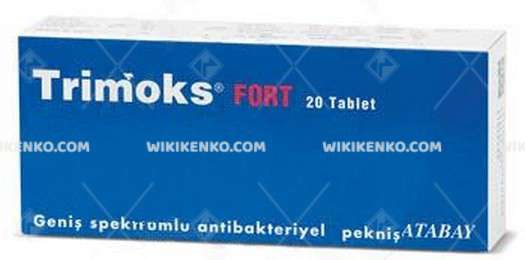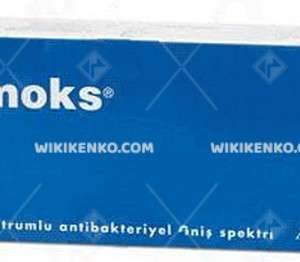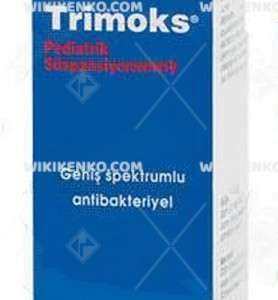Trimoks Fort Tablet
In the realm of pharmaceutical innovations, Trimoks Fort Tablet emerges as a testament to the relentless pursuit of combating bacterial infections. Manufactured by Atabay, a company with a heritage dating back to its inception in Istanbul in 1939, this medication is a formidable player in the antibiotic arena. This article unveils the multifaceted aspects of Trimoks Fort Tablet, shedding light on its active ingredients, mechanism of action, uses, benefits, side effects, and precautions.
| Dosage form | |
|---|---|
| Pack size | |
| Potency | 800 Mg/160Mg |
| Manufacturer | |
| Origin | |
| Generic Name (Ingredient) | Sulfamethoxazole (Smz) 800 Mg Trimethoprim (Tmp) 160 Mg |
Assuming your emergency circumstances for this product, visit Urgent Quotation page. Besides, for any pharmaceutical questions, please ask us in the comments section.
Description
Active Ingredients
Trimoks Fort Tablet’s efficacy lies in its composition, housing two key active ingredients:
- Sulfamethoxazole (800 mg)
- Trimethoprim (160 mg)
These components form a dynamic duo in the fight against bacterial pathogens, and their mechanisms of action are worth exploring.
Mechanism of Action
Trimethoprim, a diaminopyrimidine, takes center stage with its pivotal role as a reversible inhibitor of dihydrofolate reductase. This enzyme is a linchpin in the conversion of bacterial dihydrofolic acid to tetrahydrofolic acid, an essential step in the synthesis of nucleic acids and proteins. Trimethoprim’s actions can be either bacteriostatic or bacteriocidal, making it a versatile combatant on the same metabolic pathway as sulfonamides.
Antimicrobial Effects
Trimethoprim deploys its antimicrobial prowess by obstructing a critical juncture in the synthesis of bacterial nucleic acids and proteins. This multifaceted agent demonstrates efficacy against an array of gram-negative bacterial species, while also challenging the resilience of coagulase-negative Staphylococcus species.
Resistance
Bacterial resistance is a persistent adversary, and Trimoks Fort Tablet is not exempt from this challenge. Resistance to trimethoprim can manifest through various mechanisms, including:
- Alterations to the bacterial cell wall
- Overproduction of dihydrofolate reductase
- Production of resistant dihydrofolate reductase
These adaptations underscore the need for ongoing vigilance in the realm of antibiotic therapy.
Uses
Trimoks Fort Tablet finds its niche in the treatment of initial episodes of uncomplicated urinary tract infections, attributed to susceptible strains of various organisms, including Escherichia coli, Proteus mirabilis, Klebsiella pneumoniae, Enterobacter species, and coagulase-negative Staphylococcus species, encompassing S. saprophyticus. This targeted approach ensures that the medication is employed where it can make the most significant impact.
Trimoks Fort Tablet Benefits
Trimoks Fort Tablet, armed with Sulfamethoxazole and Trimethoprim, is not limited to a single battleground. Its therapeutic potential extends to a spectrum of infections, including:
- Pneumocystis Jiroveci Pneumonia: An effective combatant against this challenging respiratory infection.
- Toxoplasmosis: An essential player in the treatment of Toxoplasmosis.
- Nocardiosis: An ally in the fight against Nocardiosis.
- Urinary Tract Infections: A reliable choice for addressing acute uncomplicated urinary tract infections.
- Acute Otitis Media: A valuable asset in the resolution of acute otitis media.
- Chronic Bronchitis: A frontline defender against the exacerbation of chronic bronchitis.
Beyond these core applications, Trimoks Fort Tablet is a versatile soldier in the battle against conditions such as Acute Exacerbation of Chronic Bronchitis, Acute Otitis Media caused by susceptible bacteria, Bacterial Conjunctivitis caused by susceptible bacteria, and Blepharoconjunctivitis caused by susceptible bacteria.
It’s important to emphasize that Trimoks Fort Tablet should only be administered under the guidance of a healthcare professional, and adherence to the prescribed dosage is paramount. Completing the full course of treatment, even if symptoms subside, is not only a best practice but also a crucial measure to prevent the emergence of antibiotic-resistant strains.
Side Effects
As with any medication, Trimoks Fort Tablet carries the potential for side effects, albeit not universally experienced. These side effects encompass a spectrum, including:
Common Side Effects:
- Stomach pain
- Nausea
- Vomiting
- Diarrhea
- Vaginal itching or discharge
- Headache
- Swollen, black, or “hairy” tongue
Other Side Effects:
- Pruritus (itching)
- Rash
- Urticaria (hives)
- Mild GI disturbance (e.g., nausea, vomiting, glossitis, sore mouth)
- Disturbance of liver enzymes
- Photosensitivity (skin sensitivity to sunlight)
- Angioedema (swelling under the skin)
- Myalgia (muscle pain)
- Hyperkalaemia (high potassium levels in the blood)
- Hyponatraemia (low sodium levels in the blood)
- Agranulocytosis (low white blood cell count)
Overdose Symptoms:
In the event of an overdose, symptoms may encompass confusion, behavioral changes, a severe skin rash, reduced urine output, or seizures.
Allergic Reactions:
Allergic reactions to Trimoks Fort Tablet may manifest as hives, breathing difficulties, and facial swelling.
It’s crucial to recognize that this is not an exhaustive list of side effects, and individual responses may vary. If adverse effects are encountered during Trimoks Fort Tablet use, prompt consultation with a healthcare provider is imperative.
Precautions
As with any medication, Trimoks Fort Tablet necessitates adherence to a set of precautions. These include:
General Precautions:
- Allergies: Disclose any allergies, particularly if you are allergic to cephalosporins like Ceclor, Ceftin, Duricef, Keflex, or others.
- Medical Conditions: Inform your healthcare provider of any pre-existing conditions, including asthma, liver or kidney disease, bleeding or blood clotting disorders, mononucleosis, or any allergies.
- High Potassium Levels: Avoid Trimoks Fort Tablet if your blood potassium levels are elevated.
- Severe Diarrhea: If you have previously experienced severe diarrhea while taking antibiotics, consultation with your healthcare provider before using Trimoks Fort Tablet is advisable.
Special Instructions:
- Creatinine Clearance: The use of Trimoks Fort Tablet is not recommended for patients with a creatinine clearance of less than 15 ml/min. For those with a creatinine clearance of 15 to 30 ml/min, the dosage should be 50 mg every 12 hours.
- Antibiotic Resistance: Given the geographical variance in antimicrobial susceptibility patterns, consulting local antibiograms is prudent to ensure adequate coverage of relevant pathogens before initiating therapy.
Dosage
The appropriate dosage of Trimoks Fort Tablet is a critical component of its effectiveness. The dosing guidelines are as follows:
Adult Dosage:
For adults, the usual oral dosage consists of either 100 mg of trimethoprim every 12 hours or 200 mg of trimethoprim every 24 hours, with each regimen spanning 10 days. The choice of dosage is determined by your medical condition and your response to treatment.
Pediatric Dosage:
Children are not forgotten in the therapeutic landscape. The pediatric dosage entails 8 mg/kg of trimethoprim and 40 mg/kg of sulfamethoxazole per 24 hours, administered in two equally divided doses every 12 hours.
Dosage for Pneumocystis Carinii Pneumonia:
In cases of documented Pneumocystis carinii pneumonia, the recommended dosage involves 15 to 20 mg/kg of trimethoprim and 75 to 100 mg/kg of sulfamethoxazole per 24 hours. These doses should be equally divided and administered every 6 hours for a duration of 14 to 21 days.
As with all medications, the administration of Trimoks Fort Tablet should be guided by a healthcare professional, and adherence to the prescribed dosage is essential. Completing the full course of treatment, even if symptoms abate, is imperative to ensure the complete eradication of the infection and to thwart the development of antibiotic-resistant strains.
Conclusion
In conclusion, Trimoks Fort Tablet stands as a testament to the progress of antibiotic therapy, offering a potent blend of Sulfamethoxazole and Trimethoprim. Its mechanisms of action, applications, benefits, potential side effects, and precautions collectively shape a comprehensive landscape for healthcare professionals and patients alike. This pharmaceutical achievement underscores the necessity for precise and responsible medication management. The battle against bacterial infections continues, with Trimoks Fort Tablet as a stalwart ally.
Essential Details
| Active Ingredients | Sulfamethoxazole (800 mg) and Trimethoprim (160 mg) |
|---|---|
| Mechanism of Action | Inhibition of dihydrofolate reductase and synthesis of nucleic acids and proteins |
| Antimicrobial Effects | Activity against gram-negative bacteria and coagulase-negative Staphylococcus species |
| Resistance Mechanisms | Alterations to bacterial cell wall, overproduction of dihydrofolate reductase, resistant dihydrofolate reductase |
| Common Uses | Uncomplicated urinary tract infections due to susceptible strains of Escherichia coli, Proteus mirabilis, Klebsiella pneumoniae, Enterobacter species, and coagulase-negative Staphylococcus species, including S. saprophyticus |
| Benefits | Treatment of Pneumocystis Jiroveci Pneumonia, Toxoplasmosis, Nocardiosis, urinary tract infections, acute otitis media, exacerbation of chronic bronchitis, and more |
| Side Effects | Common and rare side effects, including gastrointestinal disturbances, allergic reactions, and potential overdose symptoms |
| Precautions | Considerations for allergies, medical conditions, potassium levels, and past antibiotic experiences |
| Dosage Guidelines | Specific dosing information for adults, children, and cases of Pneumocystis carinii pneumonia |
Use the form below to report an error
Please answer the questions as thoroughly and accurately as possible. Your answers will help us better understand what kind of mistakes happen, why and where they happen, and in the end the purpose is to build a better archive to guide researchers and professionals around the world.
The information on this page is not intended to be a substitute for professional medical advice, diagnosis, or treatment. always seek the advice for your physician or another qualified health provider with any questions you may have regarding a medical condition. Always remember to
- Ask your own doctor for medical advice.
- Names, brands, and dosage may differ between countries.
- When not feeling well, or experiencing side effects always contact your own doctor.
Cyberchondria
The truth is that when we’re sick, or worried about getting sick, the internet won’t help.
According to Wikipedia, cyberchondria is a mental disorder consisting in the desire to independently make a diagnosis based on the symptoms of diseases described on Internet sites.
Why you can't look for symptoms on the Internet
If diagnoses could be made simply from a textbook or an article on a website, we would all be doctors and treat ourselves. Nothing can replace the experience and knowledge of specially trained people. As in any field, in medicine there are unscrupulous specialists, differences of opinion, inaccurate diagnoses and incorrect test results.





Reviews
There are no reviews yet.